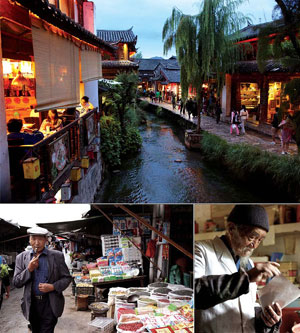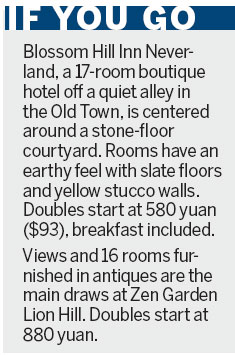
Clockwise from top: A twilight scene along one of Lijiang Old Town's canals. At 90, Dr Ho Shixiu still runs the Jade Dragon Snow Mountain Chinese Medicine Clinic. An Old Town market offers visitors a glimpse into the local people's life. Photos by Robb Kendrick / For The New York Times
Culture, history, beauty converge in an old city of Yunnan province.
The word "breathtaking" when applied to a Chinese city sometimes refers to respiratory-attack-inducing smog. But in the case of Lijiang, population 1.2 million, in Southwest China's Yunnan province, the word takes on its slack-jaw-in-awe meaning. The horizon here is Himalayan, and the blue sky above the city's stone streets, willow-lined canals and black-tiled roofs is reliably visible. This unusual troika of culture, history and natural beauty is why Lijiang's Old Town - a UNESCO World Heritage Site and a center of the Naxi people - is a top destination for Chinese tourists and a new favorite of the passport-carrying crowd.
Friday, 4 pm
Lijiang was built for commerce about 800 years ago, and a commercial city it remains. Once a crucial trading post on the ancient Tea and Horse Caravan Road connecting Yunnan province and the Tibet autonomous region, it now caters, in large part, to tourists from Beijing and Hong Kong (who apparently really, really like dried yak meat).
The main thing to know about shopping in the pedestrian-only Old Town is that many stores, like those selling hammered silver jewelry and tea bricks, repeat themselves on nearly every street, like the scrolling background in a Tom and Jerry cartoon chase scene.
Browse a few hours through the Mao kitsch (like the canvas "Oba Mao" bags with US President Barack Obama in a Mao suit). You'll find there are many Donga Paper Workshops, a chain that sells paper lampshades and books of locally made paper, but head to the one at Lower Xinyuan Lane, Guangyi Street, where you can make your own sheet in the traditional way. Bunong Bells sells stylized bells (from 160 yuan, or $26) like those worn by horses on the caravan trail.
7 pm
In Square Market, Old Town's main plaza, visitors snake around horsemen trying to attract paying riders. Naxi dance groups bend, clap and spin. To take all this in, rise above it. The second-floor Bells Restaurant and Bar offers a fine selection of New Zealand red wines by the bottle in the 300-yuan range and a view of the action below.
8 pm
In the front window of 88 Snack, a woman slices strips of pea jelly made from black beans. Behind this unassuming facade is the best restaurant in town for Naxi fare. The Dongba spicy chicken lives up to its name, and the roasted eggplant salad is garlic heaven. The adventurous can try deep-fried dragonflies, which taste like especially crunchy seaweed. (Dinner, 110 yuan for two.)
10 pm
The antidote to "Bar Street" (aka Xinhua Street), where nightclubs feature skull-thumping music and where boy bands with high hair dance in spotlights, is Freshnam Cafe, on a quiet strip across town. People come to Freshnam, run by a Korean impresario, Nam Ji-woo, for the simple setting (black bar and small stage), the international beers and the music, which runs toward the folk-rock vein, though with any luck you'll catch a belly-dance number.
Saturday, 9 am
Morning is the ideal time to wander through the Old Town. Without the crush of other tourists, the arching stone bridges over the three branches of the Yuhe River that flow through town, the ivied walls and the flowering trees sheltering koi-filled canals seem even lovelier. Getting lost in a serpentine alley is the best way to appreciate Naxi architecture - white stucco walls, heavy wood doors, beams and shutters, and sweeping roofs with ridgelines that bend up at the ends, like yogis in a cobra pose.
The perfect breakfast can be found on a section of Qiyi Street with food vendors offering boiled eggs on a stick, shredded potato pancakes, grilled dumplings and what looks like a Chinese version of a breakfast taco (with egg and greens inside). Treats go for 10 yuan each.
11:30 am
About 9 km north of the Old Town is the one-street village of Baisha. The original capital of the Naxi people, before it moved to Lijiang, Baisha sits at the base of Jade Dragon Snow Mountain. The scenic way to get to Baisha is by bike; rent one for 200 yuan a day from Ali Baba Cafe. You'll ride past the dramatic Black Dragon Pool and the Qingxi Reservoir.
The ratio of impressive cafes and shops per square meter is higher than in Lijiang. Still, the feel here is more relaxed - unless you're one of the Naxi elders who play a fierce game of mahjong on the street corner.
2 pm
The restaurant at the Here features elegant pastas, wood-fired pizzas and cats. The house cats are called Pasta and Pizza, and when you order one of those dishes, the Here will donate 1 yuan to a cat rescue fund. The pasta plates - especially the mushroom ravioli and the gnocchi with Gorgonzola sauce - rise far above the norm in China: 150 yuan for two.
3:30 pm
You can't come to Baisha and miss out on Dr Ho Shixiu, who runs the Jade Dragon Snow Mountain Chinese Medicine Clinic. Ho, 90, will diagnose ailments (in good English) and talk herbs, health and happiness. Suggested donation for a consultation and a bag of his mysterious tea: 100 to 300 yuan.
7 pm
Back in Lijiang, the apparent logic behind the Prague Cafe's name is its bohemian sensibility: a jazz sound track, colorful pillows on the wood booths and walls lined with books. The food is a multinational mix, including sirloin steaks, plump burgers, chicken curry, Chinese standards and Japanese dishes like katsudon - lightly breaded pork cutlets in a spicy sauce. Dinner for two with drinks: 150 yuan.
9 pm
When you step out of the Prague Cafe, turn to the left and you'll find a stall selling candle boats made from Styrofoam egg cartons to look like lotus blooms (10 yuan). Walk down the stairs to the canal and make a wish as you place the candle in the water. Then mosey down the street beside the canal, to the Old Stone Bridge, where you can watch your boat approach in a sparkling flotilla.

9:30 pm
John McSweeney advertises his bar, Stone the Crows, as an "Irish-run pub". Furnishings are few beyond the small bar, a pool table, a dart board and an incongruous punching bag, but the drinks are the main attraction anyway - mojitos, tequilas, absinthe and beer, including, of course, Guinness.
Sunday, 10 am
To find N's Kitchen, look for the bright yellow stairs; each step extols a restaurant highlight, including "Home Made Bread" and "Nice Coffee". Upstairs, ferns, bike helmets hanging from the ceiling and a fake Christmas tree give the place a hippie vibe. Breakfast includes hash browns, smoothies and fat pancakes. Breakfast for two: 95 yuan.
Noon
Many tourists head to Mu's Residence because this former home of Lijiang's ruling family looks like a downsized Forbidden City. But after a quick look, follow the path that winds up the hill past a Taoist temple. Partway up, you'll enter Lion Hill Park, where you can wander among 800-year-old cypress trees, with an expansive view of rooftops below and mountains beyond. At the top of the hill by the five-story-high Wangu Tower, you'll find a large "Peace Bell". Ring it and break the silence far above the bustle below.
The New York Times
By Jeannie Ralston (China Daily)
